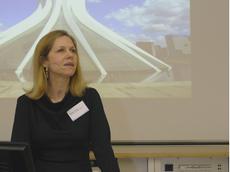Novatlantis - The ISCN Conference
Novatlantis recently hosted the 2008 International Sustainable Campus Network (ISCN) conference at ETH Zurich’s Honggerberg campus. Sustainability was the focus, with experts at the conference agreeing that the 2000 watt society is still the best means to achieve it, not only on university campuses but also on a global scale.

The ISCN conference drew experts and decision-makers from twenty-five universities around the world. Under discussion was the design and management of sustainability on campuses with the aim of establishing a unified and uniform foundation for the Network. The Network believes that with more than 500 university campuses currently in planning around the world, particularly in Asia, and with the expected expansion or renovation of many more established university campuses, there is an immediate need to “develop a knowledge system” that would allow the standardization of best practices in sustainability. The ISCN conference is the framework in which members can report their experiences, and where successful projects may serve as encouragement and inspiration to other institutions working towards sustainable campuses. ETH Zurich, as one of the ten member of the International Alliance of Research Universities, IARU, is also part of the drive towards sustainable campuses.
The 'Nobel of Architecture'
At last year’s inaugural conference, the Novatlantis-hosted ISCN stated its founding premise: to build a society in which all citizens have equal and fair access to energy sources. This year’s conference continued the theme. The conference’s keynote speaker, Martha Thorne of the Hyatt Foundation, sponsors of the Pritzker Architecture Prize, reviewed the history of the prize and its continued and growing relevance and importance in the field of architecture. She underscored the similarity in purpose that the “Nobel of architecture” has to that of Novatlantis, and so ISCN: all of the organizations address sustainability and do their part to try to achieve.
Mrs. Thorne noted that since 2002 sustainability has increasingly become a factor in the Pritzker jury’s determination of who will be awarded the prize, and demonstrated this fact with a quick review of some of the prize’s equally prestigious winners since that year. In 2002 the Pritzker jury awarded Glenn Murcutt of Australia the award for his economical yet highly-functional work that remains in harmony with its natural surroundings. Brazil’s Paulo Mendes da Rocha received recognition for his commitment to a vision that treats buildings and landscapes as a whole. He himself has referred to at least one of his buildings “a multifaceted event in the landscape”. ETH Zurich professors Jacques Herzog and Pierre de Meuron were honored for their work in ‘advancing the art of architecture’, and Jean Nouvel of France, architect of the Cultural and Conference Center in Lucerne, Switzerland, and the 2008 Pritzker Prize recipient was cited for his new approach to conventional problems in architecture.
2000 watt society
The Director of Novatlantis, Roland Stutz, delivered the conference’s welcoming address. He remains adamant that the best strategy to implement sustainability on campuses is the 2000 watt society, despite ETH Zurich’s recent adoption of the One Ton C02 strategy. Comparing the two strategies, he said “the 2000 watt society is a more comprehensive approach with more sustainable aspects, for example, socially and economically.” Of overriding importance, he feels, is that we must all change the way we use natural resources so that they are used in more efficient and renewable ways. The two approaches to a common goal notwithstanding, Mr. Stutz said there is a potential stumbling block that needs to be be addressed. The most pressing challenge now, he said, is to avoid further confusion because people are already asking, “What does it mean, two messages coming from the same institution?”
Pritzker Prize
Established in 1979, the Pritzker Prize has become architecture’s highest honor. It is presented to a living architect who, through commitment, vision and talent, has contributed to humanity through the art of architecture.







READER COMMENTS